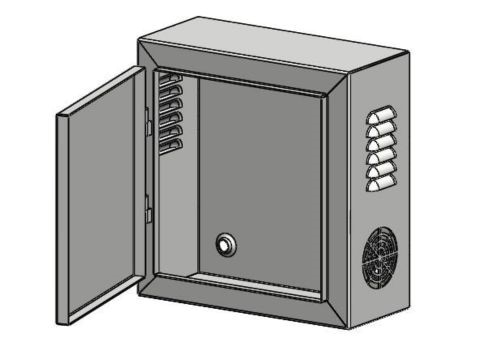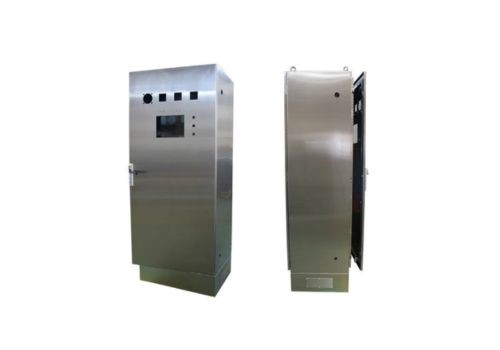Stop wondering how Manufacturers make Electrical Enclosures; we will expose everything about the Electrical Enclosure Manufacturing Process in easy-to-understand steps.
While there are many electrical enclosures, they are made from various materials and undergo different procedures.
Electrical Enclosure Manufacturing Process in Easy Steps
The electrical enclosures are more than just metal boxes; they provide safety against harsh conditions like heat or corrosion. Let’s dive into how manufacturers make these electrical enclosures in a few steps.
Step 1: Manufacturer’s Choosing Electrical Enclosures Based on Specifications
First, you need to understand the differences affecting the manufacturing process of electrical enclosures. Before this process, all the manufacturers look at these factors to determine what they will create and need. These factors are:
- Safety Ratings (IEC, UK, IP) match usage.
- Custom, trough, wall-mounted, or floor-mounted enclosures to use indoors or outdoors.
- Use durable materials like carbon steel, stainless steel, or plastic.
- Include gaskets, vents, windows, hinges, latches, and cutouts for functionality and safety.
- Look for Dimensions for custom designs.
- Select the appropriate voltage, limitations, and frequency.
- Using Indoor or Outdoor
Step 2: Designing the Electrical Enclosure with Software
The second step is to decide the design of the electric enclosure, and it also depends on factors like whether this enclosure is for outdoor needs or indoors.
However, there are specific software to design enclosures that best suit your requirements.
After confirming all the features of an enclosure, the design process involves certain procedures.
That is – drawing out some rough designs and making them more vibrant and understandable with 3D models.
The design should be perfect in size and dimensions to easily tackle other problems during assembly and fabrication. However, they usually use CAD software to design the structure and measurements properly in a 3D form design.

Step 3: Choosing the Right Material for the Enclosure
Choosing the suitable material for your enclosure is the most important step. However, the three most popular and commonly used materials by manufacturers are aluminum, stainless steel, and carbon steel.
However, every material has its own power and resistance level, and they have different costs, too.
Likewise, aluminum is not that heavy metal and is mostly preferred indoors because it is resistant to corrosion and heat.
Metals:
- Carbon Steel: Manufacturers choose carbon steel when they are looking for a cost-effective, durable material. It works best indoors and outdoors, but it still needs powder coating or galvanized to increase resistance against corrosion.
- Stainless Steel: No doubt it’s the best choice for resistance against heat and corrosion, and it lasts longer than carbon steel. Likewise, it makes stainless steel ideal for any use.
- Aluminum: Aluminum is the best choice if you want a lightweight but strong and aesthetic enclosure. This material can resist heat and corrosion but could improve moisture resistance.
Choosing the Right Enclosure Material:
Manufacturers look for different factors before choosing any electrical enclosure materials, such as:
- Cost
- Heat Dissipation
- Temperature Requirements
- Weight Constraints
- Moisture Levels
- Enclosure Contents
- Security Concerns
- Environmental Conditions
You can also learn more about electrical enclosure material.
Step 4: Fabricating & Machining of Electrical Enclosure
Fabrication of the enclosure starts after you choose a specific material. Meanwhile, it consists of some steps like cutting, drilling and bending to different shapes for perfect designs. Also, this process depends on the material you choose.
Cutting:
At the beginning of the manufacturing process, a precise cut of metals is very important. Meanwhile, it is usually hard to get the perfect size and dimensions after cutting the metal sheets. Some of the common cutting methods are:
- Shearing: Blades cut material to size.
- Punching: Die punches holes in material.
- Blanking: Die cuts material to size.
- Water jet: High-pressure water cuts material.
- Laser cutting: Laser burns material to cut.
Drilling and Tapping
After welding, they start drilling the enclosures with holes for mounting components like cable, entry points, or grounding connections. All this is done on an excellent tapping in the end.
Bending:
After cutting the metal sheets, the blending machine perfectly folds them into different shapes using a V-shaped die and punch. Different blending techniques require various types of configurations and machines.
- Channel Bending
- Edge Bending
- U-Bending
- V-Bending
- Offset Bending
Welding:
Welding techniques like MIG or TIG permanently join the enclosure parts. Seams are carefully welded and polished to ensure a smooth and robust enclosure.
You can go for welding when you finally blend the metal sheets into different shapes. Likewise, there are different welding methods, such as MG or TIG. First, they are fixed with welding, and then they polish the metals to give them the best look. Some commonly used welding methods are:
- Seam welding
- Resistance spot welding
- Explosion welding
- Electron beam welding
- Flash welding
- Arc welding
- Laser Welding
- Friction welding
- Cold pressure welding
Assembly:
After drilling the holes and bending the enclosures, the time comes to assemble and join the enclosure parts. While it can be constructed by hand or by using some machinery, it is typically difficult to do with hands. Some of the assembly methods are:
- Join parts with screws, rivets, or fasteners.
- Weld parts with heat using arc, flash, or spot methods.
- Use epoxy, glue, or tape for plastic parts.
Machining:
Usually, it involves the removal process of material from the enclosures using tools like lathes, milling, or drilling machines. However, the purpose of machining is to make different door openings and to improve the appearance of electrical enclosures.
Some of the machining methods are:
- Slotting
- Piercing
- Parting
- Notching
- Slitting
- Perforating
Step 5: Applying a Surface Finish

The surface finishing is essential for the best aesthetics and makes the metals resistant to heat and corrosion. Some of the best surface finishing methods are:
Coating
Manufacturers usually do powder coating or wet painting, which protects the enclosures against corrosion or other harsh conditions.
While powder coating is eco-friendly and affordable, it also lasts longer compared to wet painting.
For more protection, you can even use UV light or the heat process on this coating for outdoor environments. Also, you can use various types of colors with multiple textures for better aesthetic finishing. Some enclosure coating methods are:
- Applies powder for corrosion resistance, cured with heat or UV.
- Uses primer and paint for color customization.
- Adds thin metal layer for aesthetics or durability.
- Electrolytic process for durable aluminum surface.
- Applies graphics or images directly onto enclosure.
- Adds markings for identification or decoration.
Anodizing
In the case of aluminum metals, manufacturers usually prefer an anodizing method for a better finishing, which increases the thickness of layers.
Meanwhile, metal powder coating gives aesthetic protection to the surface of the metal surface. In simple words, it’s like an acid bath; you put aluminum in acid to make it safe and thicker.
Plating
Next is metal plating, which has basically three types:
- Immersion Plating
- Electroless Plating
- Electroplating
Electroplating uses an electric current to coat the enclosure parts. Meanwhile, the electroless plating relies on an autocatalytic reaction.
Meanwhile, Immersion plating uses the metal substrate to trigger the reaction, forming a thin metal deposit like silver or zinc. This chemical process is typically done in specialized facilities.
Step 6: Electrical Enclosure Quality Inspection
To get the best electrical enclosure, manufacturers always make sure the quality is top-notch while following all the protocols.
From the start of the electrical enclosure manufacturing process, they keep multiple factors and rules in mind. You should always follow the requirements set by multiple industries, such as IEC, ISO, NEC, ANS, and others.
There are certain quality inspection tests before these electrical enclosures go into markets, which are given below:
- Surface Finish Inspection: Dust and Sand Impact Testing
- High Accelerated Stress Screening (HASS)
- Highly Accelerated Life Testing (HALT)
- Salt Spray Corrosion Testing
- Vibration Testing
- Thermal Shock Testing
- Humidity Testing
- Accelerated Weathering Testing
- Ingress Protection (IP) Testing
- Temperature Variation Testing
- Hail Impact Testing
- Solar Radiation Testing
Step 7: Packaging and Shipping
After the successful quality inspection, the last step is the packaging and shipping. In this step, these enclosures are packed before any transportation to provide safety against corrosion, moisture, or scratches.
This is the final step when these electrical enclosures are delivered to specific locations.
However, the enclosure packaging depends on various things like size, weight, fragility, and the method of shipment. Meanwhile, the small-sized enclosures are packed into cardboard boxes. On the other hand, large enclosures are packed into wooden crates for good safety.
Conclusion
Knowing how an electrical enclosure is manufactured reveals the careful steps taken in creating one. Every step, from selecting materials to quality inspections, guarantees safe and valuable products. However, only perfectly designed and accurately manufactured electrical enclosures can handle complex situations. From dealing with harsh weather conditions, chemicals, and corrosion, they are made to provide safety to your systems.
More resources:
Electrical Enclosure Safety – Source: KDM
How to Remove Powder Coat on Electrical Enclosure – Source: KDM
Top 30 Electrical Enclosure Manufacturers in USA and China – Source: KDM
NEMA 13 Enclosure – Source: KDM




